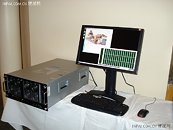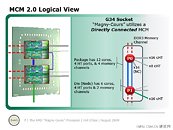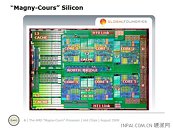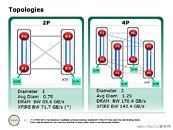Wednesday, August 26th 2009

AMD Demos 48-core ''Magny-Cours'' System, Details Architecture
Earlier slated coarsely for 2010, AMD fine-tuned the expected release time-frame of its 12-core "Magny-Cours" Opteron processors to be within Q1 2010. The company seems to be ready with the processors, and has demonstrated a 4 socket, 48 core machine based on these processors. Magny Cours holds symbolism in being one of the last processor designs by AMD before it moves over to "Bulldozer", the next processor design by AMD built from ground-up. Its release will provide competition to Intel's multi-core processors available at that point.
AMD's Pat Conway at the IEEE Hot Chips 21 conference presented the Magny-Cours design that include several key design changes that boost parallelism and efficiency in a high-density computing environment. Key features include: Move to socket G34 (from socket-F), 12-cores, use of a multi-chip module (MCM) package to house two 6-core dies (nodes), quad-channel DDR3 memory interface, and HyperTransport 3 6.4 GT/s with redesigned multi-node topologies. Let's put some of these under the watch-glass.Socket and Package
Loading 12 cores onto a single package and maintaining sufficient system and memory bandwidth would have been a challenge. With the Istanbul six-core monolothic die already measuring 346 mm² with a transistor-load of 904 million, making something monolithic twice the size is inconceivable, at least on the existing 45 nm SOI process. The company finally broke its contemptuous stance on multi-chip modules which it ridiculed back in the days of the Pentium D, and designed one of its own. Since each die is a little more than a CPU (in having a dual-channel memory controller, AMD chooses to call it a "node", a cluster of six processing cores that connects to its neighbour on the same package using one of its four 16-bit HyperTransport links. The rest are available to connect to neighbouring sockets and the system in 2P and 4P multi-socket topologies.
The socket itself gets a revamp from the existing 1,207-pin Socket-F, to the 1,974-pin Socket G34. The high pin-count ensures connections to HyperTransport links, four DDR3 memory connections, and other low-level IO.Multi-Socket Topologies
A Magny-Cours Opteron processor can work in 2P and 4P systems for up to 48 physical processing cores. The multi-socket technologies AMD devised ensures high inter-core and inter-node bandwidth without depending on the system chipset IO for the task. In the 2P topology, one node from each socket uses one of its HyperTransport 16-bit links to connect to the system, the other to the neighbouring node on the package, and the remaining links to connect to the nodes of the neighbouring socket. It is indicated that AMD will make use of 6.4 GT/s links (probably generation 3.1). In 4P systems, it uses 8-bit links instead, to connect to three other sockets, but ensures each node is connected to the other directly, on indirectly over the MCM. With a total of 16 DDR3 DCTs in a 4P system, a staggering 170.4 GB/s of cumulative memory bandwidth is achieved.Finally, AMD projects a up to 100% scaling with Magny-Cours compared to Istanbul. Its "future-silicon" projected for 2011 is projected to almost double that.
Source:
INPAI
AMD's Pat Conway at the IEEE Hot Chips 21 conference presented the Magny-Cours design that include several key design changes that boost parallelism and efficiency in a high-density computing environment. Key features include: Move to socket G34 (from socket-F), 12-cores, use of a multi-chip module (MCM) package to house two 6-core dies (nodes), quad-channel DDR3 memory interface, and HyperTransport 3 6.4 GT/s with redesigned multi-node topologies. Let's put some of these under the watch-glass.Socket and Package
Loading 12 cores onto a single package and maintaining sufficient system and memory bandwidth would have been a challenge. With the Istanbul six-core monolothic die already measuring 346 mm² with a transistor-load of 904 million, making something monolithic twice the size is inconceivable, at least on the existing 45 nm SOI process. The company finally broke its contemptuous stance on multi-chip modules which it ridiculed back in the days of the Pentium D, and designed one of its own. Since each die is a little more than a CPU (in having a dual-channel memory controller, AMD chooses to call it a "node", a cluster of six processing cores that connects to its neighbour on the same package using one of its four 16-bit HyperTransport links. The rest are available to connect to neighbouring sockets and the system in 2P and 4P multi-socket topologies.
The socket itself gets a revamp from the existing 1,207-pin Socket-F, to the 1,974-pin Socket G34. The high pin-count ensures connections to HyperTransport links, four DDR3 memory connections, and other low-level IO.Multi-Socket Topologies
A Magny-Cours Opteron processor can work in 2P and 4P systems for up to 48 physical processing cores. The multi-socket technologies AMD devised ensures high inter-core and inter-node bandwidth without depending on the system chipset IO for the task. In the 2P topology, one node from each socket uses one of its HyperTransport 16-bit links to connect to the system, the other to the neighbouring node on the package, and the remaining links to connect to the nodes of the neighbouring socket. It is indicated that AMD will make use of 6.4 GT/s links (probably generation 3.1). In 4P systems, it uses 8-bit links instead, to connect to three other sockets, but ensures each node is connected to the other directly, on indirectly over the MCM. With a total of 16 DDR3 DCTs in a 4P system, a staggering 170.4 GB/s of cumulative memory bandwidth is achieved.Finally, AMD projects a up to 100% scaling with Magny-Cours compared to Istanbul. Its "future-silicon" projected for 2011 is projected to almost double that.





104 Comments on AMD Demos 48-core ''Magny-Cours'' System, Details Architecture
Intel going to MCM a Dunnington too?
If you want to compare CPUs I still fail to see how Intel will be slower, fatter and uglier considering current Intel seems to be winning vs. current AMD. Fat bottomed girls make the rocking world go round, perhaps?
Not trying to argue, just curious as to what made you think that. Thanks :toast:
(loaded all 12 cores gives me 314W from the wall..... Everything else was idle... HDDs were sleeping... ect.. 2 highspeed 102CFM 120mm fans... )
It's a great chip, don't get me wrong. Intel has pretty much blown AMD away on the performance front, and I'm sure they're making a tidy profit doing it, but I just don't see it as having a practical use to the majority of the desktop market.
Bear in mind that this is all being said in response to the implied notion of Magny-Cours on desktop, not as any kind of forward attack on Intel and/or their products.
Most applications most people use do not make effective use of parallel processing. If a dual-core is more than enough for you, you might as well throw the difference away on a 48-core machine. Parallel processing really doesn't help anyone but the server/super computing market.
I think it is only a matter of time before people catch on that more cores aren't necessarily better and focus will return to making each individual core faster. Even your most basic of word processors could benefit from a huge IPS, single core processor than it could from a multi-core processor.
The server market and the consumer market did clash for a while but I think it is only a matter of time before the go in different directions again.What's the efficiency of the PSU and how much RAM is in it? I think my 230w estimate is pretty close. :eek:
There are things that could use more than four cores for a regular user - but they're not something you do very often (encode videos, gaming, etc) - its not a common thing, and it doesnt happen often so most people dont need it.
There are two other points to go along with this: having two cores loaded on a tri or quad core with the last left to make the OS responsive for you to chat, use web browsing etc - thats useful to many people. an extra core can do wonders there.
I forgot the last one. cant have been that good.
Also, I have at least a dozen windows open most of the time - 4-5 for firefox, file manager, archiving, parity checking, Thunderbird, word, Acrobat (usually at least 1-2), explorer (for the PITA sites), photo viewer, editor, manager, news reader, etc. Plus things like image burn, Virtual box, etc that I use occasionally.
you made me remember my point two!
you're often limited by your HDD speed as well, so a 48 core machine to be rendering one video task, would need a massive SSD RAID array to keep up anyway!